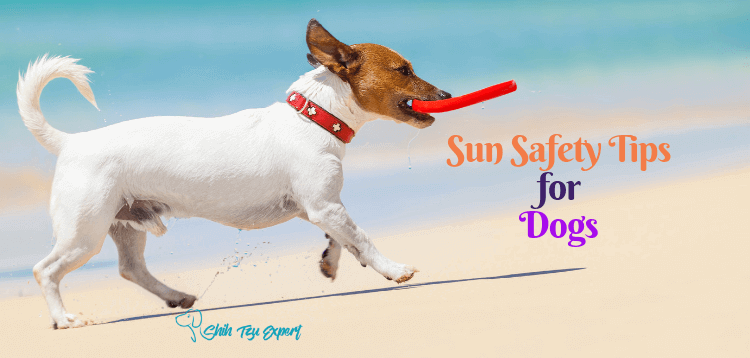
We are getting ready for the dog days of summer! Ancient Romans called summer’s hottest, most humid days “dog days” because they associated the days with Sirius, the brightest star in Canis Major, one of the constellations.
As the days heat up, dog owners need to keep in mind that the “dog days” of summer are some of the most dangerous for dogs. Heat and sun exposure are both just as dangerous for dogs as they are for humans – maybe more so, since dogs cannot take care of themselves without a human’s help. Even if temperatures are soaring, your pooch is not going to avoid the sun on its own. With that in mind, here is everything you need to know to keep your pup safe this summer.
What is the easiest way to protect my pup?
The easiest and most important way to defend a dog against the sun’s harmful ultraviolet rays is to provide shade. It is impossible to keep a pooch inside all day; every dog wants to play outside, even during summertime. When you do take your dog out, be sure there is somewhere shady, like trees or the side of a building. You could also bring an umbrella with you.
Also, keep in mind that the summer months are a particularly bad time for ticks and fleas. Always have whatever flea and tick control solution recommended to you by your veterinarian available for your pup. Routine tick checks and proper removal is crucial to your dog’s health and safety. That being said, use pup-friendly flea and tick control, not human bug spray. Insect repellent is not designed specifically for use on animals and could be toxic if inhaled by your dog.
What is the easiest way to provide quick relief?
Giving a dog water is the best way to provide immediate relief. If you see a dog that is not your own obviously overheating, get it some water and move it to a shady spot. Contact the owner if possible. Otherwise, reach out to a veterinarian or pet rescue service.
In general, pups need more water as days get hotter because it helps regulate body temperature. Always keep their bowls filled with clean, fresh water. If a dog notices that its bowl is empty, it might look for water somewhere else, like a puddle.
If you leave your pooch’s water bowl outside, the higher temperatures could accelerate the growth of bacteria and make him sick. The same goes for food. Bacteria may grow in your pup’s food bowl if there is uneaten food, so either bring the food dish inside or throw the food away.
Further, thirsty dogs might drink any liquid, even something far more hazardous than water. For example, if you are at a barbecue, your pooch might drink an alcoholic beverage, which can cause intoxication, depression, or a coma. That is why it is so, so important to stay on top of your pup’s water supply, even when you are having fun at a backyard party with friends.
While giving a dog water is a good way to provide heat relief, dumping your pup in a pool of water is not. Some dogs struggle with swimming. If you are on a boat, be sure that your pooch is wearing a flotation device in case it falls off the edge. If he is a good swimmer, be sure to rinse him off afterward to remove salt or chlorine. Do not let your dog drink the same water he swims in; it may have salt, chlorine, or other chemicals in it that could make your pup sick.
Where outside should I keep my dog?
Always have multiple shady spots outside for your dog so that they can feel free to move if they want to find a more comfortable spot. Make sure the source of shade is opaque, not translucent, otherwise it may not offer enough protection.
Try to make sure the shady areas are a patch of grass, not concrete or asphalt. Those surfaces heat up much quicker than grass and could burn your pup’s paws, even if they are not in direct sunlight.
If you want to know if a surface is too hot for your pup, check by placing the back of your hand against it. Your dog’s footpads can only withstand the heat for as long as your hand can.
Remember that shade moves with the sun. If you are leaving your pup outside to nap in a shady spot, be sure to check back frequently to make sure that the shade has not shifted while your pup sleeps, leaving him in direct sunlight.

Is there gear that can help?
Not all dogs like having accessories on their faces. But if your pup is okay with it, consider products like sunglasses, such as Doggles, or visors designed specifically for dogs. They are especially helpful if your dog has cataracts, progressive retinal atrophy, or pannus. Plus, they look extra cute on pups!
Can my dog use human sunscreen?
No! Do not put your sunscreen on your dog. Products that use zinc oxide are toxic to dogs, and zinc oxide is in almost every human sunscreen. To stay on the safe side, only use dog-friendly sunscreen. It is definitely out there; you just have to look for it.
Even if a product says it is a natural sunscreen that does not harm dogs, the best thing to do is talk to your veterinarian before trying it on your dog.
Be sure the sunscreen is “broad spectrum,” guarding against both forms of ultraviolet rays. UVA leads to skin cancer, while UVB results in sunburns. Neither one is fun for your pup.
Occasionally, your veterinarian may recommend a human sunscreen specifically for human babies or sensitive skin. Only use these if your veterinarian recommends it and gives you guidance on how to use it.
Are you sure zinc oxide is bad for dogs?
Yes, zinc oxide is very toxic for your pup, specifically when ingested. It causes gastrointestinal issues. Plus, it damages dogs’ red blood cells, leading them to explode. That results in anemia, which can be incredibly severe and require a blood transfusion.
Even if you forget your pup’s sunscreen at home and just want to keep them safe, never risk a sunscreen with zinc oxide. Instead of putting your sunscreen on your dog, just keep them in the shade as much as possible.

Applying dog sunscreen correctly
Make sure the sunscreen you get for your pup is made specifically for dogs. As mentioned above, be sure it is broad spectrum. It should also be waterproof and fragrance-free. There are tons of options for sale online; just be sure to consult with your veterinarian before purchasing. Options include Doggles sunscreen, NaturalDog Snout Soother, Petkin Doggy Sunstick, and Wolfe & Sparky Organic Dog Sunscreen.
Put sunscreen on your dog on any spot where bare skin is exposed, like the tips of the ears, the nose, and the patch of skin between the belly and the hind legs. Keep in mind that your pup might lick it off, so you have to be vigilant with sunscreen. Do not let it get in your dog’s eyes, and if you use a spray instead of a lotion, do not let your pooch inhale it.
As a general rule, reapply sunscreen every two to three hours if your pup is on land and more frequently if he is in the water. Consider speaking to your veterinarian to see if they recommend applying it more or less frequently than that.
If your pooch has a rash or is itching more than usual, wash the sunscreen off and contact your veterinarian to see if your pup has an allergy or if the sunscreen you used was actually dangerous. To try to prevent a rash on a large patch of skin, always do a test application of sunscreen onto just a small patch of skin to start.
Does my dog sweat?
Yes and no. Your dog will not sweat where it has fur. In fact, the only place on your pup with sweat glands is the footpads. They can only really cool themselves off by panting. This means that even if you can handle the heat, your dog cannot cool off as well as you, leading to heat stress.
How can I tell when enough is enough?
Your dog might love a good soak in the sun, just like some people really enjoy sunbathing. However, you need to watch closely to make sure your dog is not starting to fry outside. Once your pup starts panting, it is time to bring him inside.
It is always important to look for signs of overheating and heatstroke. If your dog shows a change in behavior, like an inability to respond to or follow commands, they may be overheating. Physical signs include an overheated body, difficulty breathing, a distant look, drooling, vomiting, a rapid heartbeat, weakness, diarrhea, seizures, and collapse.
In these cases, try to lower your pup’s core temperature. Move them to shade indoors, cover them in cool, damp towels, and make sure they remain inactive for a while. If symptoms continue after a while, bring your dog to the vet immediately.
Many pet owners do not know that dogs can get skin cancer, but it is a very real threat for pooches. You must be attentive and observant to spot signs of skin cancers in your pup. They tend not to be melanomas and as a result may be completely white, making them difficult to spot. If you notice any lumps on your dog, bring him to your veterinarian for an examination as soon as possible. Even if you are not sure whether or not it is cancer, bring your dog in because the longer you wait, the more the cancer is able to spread. It could become too late to treat if you delay a visit to your veterinarian for too long.
Should I ever bring my pup in earlier than that?
Another reason to bring your pooch inside early is if he is on the light-skinned side of the spectrum or has light-colored fur, like gold or white. If your dog has a pink snout, that means he is more prone to sunburns and other forms of sun irritation.
If your pup has a flat face, then it is not able to pant as effectively, leaving it more susceptible to heat stroke. Be sure to bring your dog in before it starts panting in that case because panting could mean it is already being struck by heat stroke.
Other dogs that should be brought in early are those who are elderly, overweight, sick with a heart or lung disease, or have allergies.
But my dog really loves laying in the sun!
Everyone enjoys sunbathing every once in a while, especially dogs. Vitamin D is important for all pups. Humans can absorb vitamin D through their skin, but dogs cannot. The sun breaks down oils in pups’ skin, which they then lick up. The oils convert into vitamin D after being licked up and then moves to the dog’s internal organs.
Vitamin D is crucial to pups. It helps to maintain the heart, muscles, bones, and nerves and regulates the metabolism of minerals. Plus, it plays a part in gene expression.
However, it can be dangerous to let a dog sunbathe for too long. If your pup gets upset being stuck inside, consider leaving a window’s blinds open so that sunshine is able to get in. That way, your dog can sunbathe while in the air conditioning. However, be sure the window itself is not open, especially if it is unscreened. Your pup could fall out the window!
Even indoors, be sure not to let your dog stay in the sun for too long. Sunlight streaming through windows is still incredibly dangerous.
Protecting your pup from too much sunshine can be as simple as alternating between sun and shade, making your pup take inside breaks out of direct sunlight to cool off before getting back out there. A sunburn would not be fun for your pup to deal with and you do not want him to have an increased risk for developing tumors.
It might be difficult to get your dog to enjoy the indoors, but it is definitely worth putting in the work. Have fun toys specifically for the indoors and spend lots of time playing with your dog inside until he gets used to it. That way, your pooch will be more willing to come inside.
If your desire to make your pup happy leads to a sunburn, be sure to take care of him. For a moderate burn, use a cool compress or bath to soothe the skin. Then, apply vitamin E or aloe vera. If the burn is more severe, visit your veterinarian or an animal emergency hospital as soon as possible.

What about my long-coated dog? Or my dog losing his fur?
You may think that shaving a long-coated dog is the way to go. Maybe getting rid of all that fur will keep him from overheating, right? Wrong! A coat of fur is a dog’s best defense against ultraviolet rays. If you shave your pooch, his skin will be more vulnerable, and he is more likely to get a sunburn. Plus, a dog’s fur regulates body temperature.
Instead of taking off all that fur, just give your pup some extra TLC when it comes to brushing or trimming. Removing excess fur will keep things as light as possible without exposing his skin to harsh ultraviolet rays.
On the other hand, if your pup’s fur is thinning out due to age, allergies, or stress, or your pup was shaved for a medical procedure, those patches of skin will need extra attention, like more sunscreen and less sun exposure. Talk to your veterinarian about how best to care for those areas on your pooch.
Dogs that are naturally hairless or thin-haired are more vulnerable to sunburn and skin cancer. Following the tips in this article is important for all pups, but especially for thinner-haired breeds.
Can we still go on our morning jogs?
Pups become overheated incredibly quickly, and they are not going to tell you when things are heating up too much. Remember that dogs are man’s best friends. Your pup would rather collapse from the heat stress than give up and slow down. If things get that far, it may not be possible to save him. The safest option is to stick to walking during the summer months.
Can I still bring my dog on car rides?
If the air conditioning is running and you are in the car with your pup, it should be fine to ride in the car with your dog. However, you should not ever leave your dog in a parked car if the weather is warm, no matter how long you plan to be away from the car. Cracking the windows is not enough to keep your pup safe. Even if the car is not parked in direct sunlight, it will heat up quickly, and your dog could have a heatstroke. It only takes minutes for a car to get as hot as an oven. In fact, the ASPCA reports that on an 85-degree day, the inside of a car can reach 102 degrees in just ten minutes.
Your pup might not be the only one in danger if he is left in a car on a hot day. Many places now have laws that prohibit leaving dogs unattended in motor vehicles under dangerous conditions like hot days. Your car could be damaged if someone has to save your dog and you could be charged with a crime.
If you see a stranger’s dog in a car, try to find the owner and call the police if the dog is showing symptoms of overheating. Once you call the police, you must stay on the scene until authorities or the owner arrive.
If nobody arrives to help or the dog’s life is in imminent danger, find someone else in the vicinity who agrees with your assessment and take steps such as breaking a window to remove the pup from the car. Then, get the dog water and shade and continue to wait for authorities to arrive.
When considering whether or not to bring your pup along for the ride, check in advance to see if your destination allows animals. If it does not, the best choice is to leave your dog at home. Even if you think you can be in and out in a minute, right back to your parked car and your pooch, you have no way of anticipating what delays could occur. You love your pup, so take care of him! Make the smart choice and leave your dog at home.

Times to avoid the outdoors altogether
It is best to take your pup for his daily walk early in the morning or in the late evening, as the sun is rising or setting. Not only is that true for avoiding the heat, but if your dog has trouble with children, walking them early or late is a great way to make sure that your pup does not cross paths with all of the kids who are out of school for the summer holiday.
Be sure that you pay close attention to your pup when going on walks. Watch the yards you walk past and look for signs that an insecticide or rodenticide has bene applied recently. They can be harmful to dogs when ingested. The same goes for sunscreen, bug spray, and citronella candles. Always call your veterinarian if you think your dog has ingested any of these substances.
It may be best to leave your pup at home when going to a backyard barbecue. While you are having fun, your dog could be ingesting grapes, onions, raisins, or chocolate, all of which are dangerous for dogs. In fact, any change of diet could cause digestive problems for your pup, which is why it is crucial to avoid giving your pooch human food.
Fourth of July celebrations are another important time to leave your dog at home instead of bringing it to an outdoor celebration with you. Dogs do not know inherently that they must avoid fireworks, so exposure to lit fireworks could result in severe burns or trauma. Unused or spent fireworks can contain hazardous materials, and if your pup decided to eat one of them, it could be potentially fatal.
Plus, many dogs are scared of loud noises, which could leave them disoriented, scared, or potentially lost. It is best to keep your dog at home somewhere safe from the noise, where it is quiet and escape-proof.
The same goes for thunderstorms. If there is a severe chance of rain, do not leave your pup outside. The humidity before a storm can be uncomfortable for dogs. And while water is a good way to cool off, a torrential downpour is not. It could be disorienting, and thunder could scare your pup, leading them to run away.
Always have a checkup in spring or early summer with your veterinarian. It is a great way to be prepared in advance for everything that summer brings.

![6 Best Dog Treadmills for 2023 [Buyer’s Guide] 6 Best Dog Treadmills for 2023 [Buyer’s Guide]](https://shihtzuexpert.com/wp-content/uploads/2019/04/Best-Dog-Treadmills-1.png)
![12 Best Dog Foods for Toy Breeds [Buyer's Guide] 12 Best Dog Foods for Toy Breeds [Buyer's Guide]](https://shihtzuexpert.com/wp-content/uploads/2019/05/3-5.jpg)

